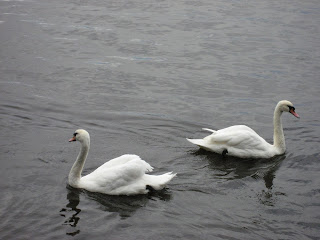Thursday
On Thursday morning I got to Israel Plads just in time to hop on the bus. For some reason I can't quite put my finger on, the bus looks like it arrived straight out of the 1970s. There are 24 students in my program, and we are accompanied by two instructors: Thorsten, our Danish-German professor, and Keith, a British professor unaffiliated with our class. Driving south from Copenhagen, we enter the Danish boondocks: expensive gas stations, convenience stores selling smørrebrød, and Jägermeister warehouses. On the way to the docks on the south coast of Sealand, we watch a depressing movie called Flammen og Citronen (Flame and Citron), about two heroic but ill-fated members of the Danish resistance.
Upon arriving at the dock, we drive onto the ferry. The ride to Lübeck, in northwestern Germany, is about 45 minutes. The wind is so strong on deck that I have to clutch my camera to take this photo:
As we near the German dock, we board the bus again and drive half an hour from the harbor to the town of Lübeck. Thorsten comments that local Germans are upset about a plan to build a bridge from one of the nearby islands to the coast.
|
 |
| Homes on a river by the harbor. |
 |
| Sheep grazing by the shore. |
 |
| Lubeck was a member of the Hanseatic League, a medieval trading bloc. Here stand the town gates. Notice that the structure looks as though it is dragging towards the center. That's because it is. The gates are build on marshland, and the heavy center building is slowly dragging the towers toward it. |
|
 |
| A quarter of Lübeck was destroyed by Allied bombing during World War II. Remarkably, this Hansa-era building in the town square survived. |
 |
| "Die Heimat Warten auf Sich" (The Homeland Waits for You). This memorial inscribed on a wall in the town square commemorates German prisoners of war held by the Soviets. Many German POWs died in Soviet captivity, and some were held well into the 1950s. An adjacent memorial honors a number of local Protestant and Catholic clergymen who were beheaded by the Nazis for dissent. |
 |
| The original bell in St. Mary's Cathedral fell and broke during a British air raid in 1942. |
|
| Although the weather is terrible, we walk around Lübeck for an hour and visit the homes of Willy Brandt and Thomas Mann. The we board the bus and drive an hour West to Hamburg. In Hamburg, it is still raining heavily. Nonetheless, we take an hour-long walking tour: |
 |
| Hamburg city center. |
 |
| City hall |
 |
| Fountain in the city hall courtyard |
 |
| Looking across the Elbe |
 |
| Tunnel under the Elbe |
We drop our stuff off at the Hotel Figaro (a sort of hotel-hostel hybrid) and go to dinner at Freischwimmer, a few blocks away.
 |
| This is what you get when you ask for a Coke in Germany. |
 |
| Sign near the bathroom. I have no idea what the hell this signifies. |
 |
| Good stuff. |
| After dinner, we walk to a nearby bar for some drinks. Two in our group challenge some Germans to a foozball match. The Germans handily beat them. Since it's a Thursday night, there isn't much going on, and we leave in search of a new bar. On the way, we are joined by a middle-aged American laser engineer from San Francisco named Eric. Eric is attending a conference in Hamburg and doesn't want to hang out with his fellow laser scientists. We search far and wide, but Hamburg is dead, and seeing as we have to wake up at 7 the next morning, it's time to go home. So we bid Hamburg's bar scene, and Eric the laser engineer, goodbye. |
|






















No comments:
Post a Comment